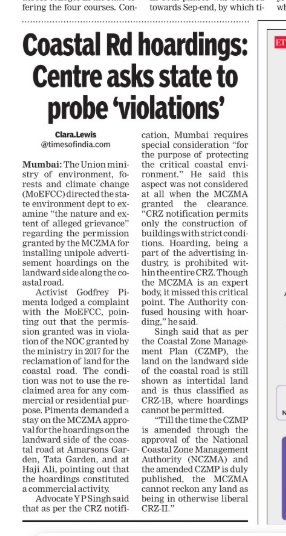BMC Questions Indian Navy Over Tree Felling at INS Trata After Complaint by Adv YP Singh

Introduction
The much-anticipated Mumbai Coastal Road has yet again found itself at the center of controversy—this time, over the installation of advertisement hoardings along its landward side. The issue has gained traction after a complaint was filed by activist Godfrey Pimenta, alleging that the approvals granted for these hoardings violate environmental norms. Now, the Union Ministry of Environment, Forest, and Climate Change (MoEFCC) has directed the Maharashtra state environment department to investigate these alleged violations. The battle over Mumbai’s coastal environment continues, raising concerns about the sanctity of environmental clearances and the preservation of the city’s fragile ecosystem.
The Controversy: What’s at Stake?
At the heart of the matter is the permission granted by the Maharashtra Coastal Zone Management Authority (MCZMA) to install unipole advertisement hoardings along the landward side of the coastal road, particularly near Amarsons Garden, Tata Garden, and Haji Ali. Pimenta argues that these approvals violate the No Objection Certificate (NOC) issued by the MoEFCC in 2017, which clearly stipulated that the reclaimed land was not to be used for commercial or residential purposes.
Pimenta’s complaint further stresses that the hoardings constitute a commercial activity that is explicitly restricted in such ecologically sensitive zones. The activist has demanded an immediate stay on the MCZMA’s approvals, emphasizing that the move undermines the conditions set forth in the original environmental clearance.
Advocate YP Singh’s Legal Standpoint
Senior advocate Adv. YP Singh has strongly criticized the MCZMA’s decision. According to him, the hoardings blatantly violate the Coastal Regulation Zone (CRZ) Notification, which is meant to protect critical coastal environments, especially in cities like Mumbai. Singh pointed out that the MCZMA overlooked key environmental safeguards while granting the clearance.
“The CRZ notification permits only the construction of buildings under strict conditions,” said Singh. “Hoardings are a part of the advertising industry, which is prohibited within the entire CRZ. The MCZMA, despite being an expert body, has erred by confusing housing regulations with hoarding regulations.”
CRZ Classification: Where Do the Hoardings Stand?
One of the most crucial aspects of this controversy lies in the land classification under the Coastal Zone Management Plan (CZMP). As per Singh’s argument, the land on the landward side of the coastal road is still designated as intertidal land, falling under the CRZ-1B category. This classification prohibits any form of commercial activity, including advertising hoardings.
Singh further clarified that unless the CZMP is amended and approved by the National Coastal Zone Management Authority (NCZMA), the MCZMA cannot treat the land under a more relaxed CRZ-II category. As of now, the hoardings remain legally impermissible under existing environmental regulations.
Why This Matters?
The installation of hoardings along Mumbai’s Coastal Road is not merely a matter of advertising; it is a larger issue concerning environmental governance, transparency, and adherence to legal norms. If authorities permit commercial activities in ecologically sensitive zones, it sets a dangerous precedent for future projects. The rapid urbanization of Mumbai has already led to massive environmental degradation, and any further encroachments upon coastal ecosystems could have irreversible consequences.
Additionally, the issue highlights the challenges in enforcing environmental laws in the face of commercial interests. If the MCZMA’s decision is upheld, it could pave the way for further violations of CRZ regulations, threatening Mumbai’s delicate coastal environment.
What’s Next?
With the MoEFCC now directing the state environment department to examine the extent of these alleged violations, the issue is set to undergo further scrutiny. If found guilty of breaching CRZ norms, the MCZMA may have to revoke its approval, leading to the removal of the hoardings. However, if the MCZMA justifies its stance, it could lead to prolonged legal battles and further disputes over environmental clearances in Mumbai.
As citizens, activists, and legal experts continue to push for accountability, the outcome of this case will set a significant precedent for how India manages its fragile coastal zones amid rapid urban expansion.
Conclusion
The Mumbai Coastal Road project, envisioned as a game-changer for the city’s infrastructure, is once again under scrutiny—this time, for reasons that raise serious environmental concerns. With activists like Godfrey Pimenta and legal experts like Adv. YP Singh stepping up to challenge the approvals, the debate over the legality of these hoardings continues.
The decision that follows will determine whether Mumbai’s coastal ecosystem is protected or further exposed to commercial exploitation. The eyes of environmentalists, legal professionals, and concerned citizens remain fixed on the authorities as they investigate this pressing issue.
